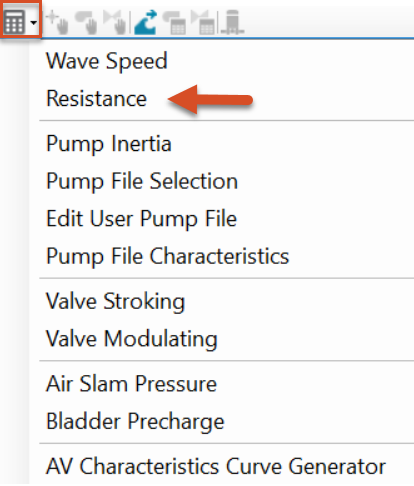Step-by-step guide
In InfoSurge Pro, surge protection devices (SPDs) can help reduce the magnitude of pressure waves resulting from transients in a pipe network. This example sets up a closed surge tank, and then examines how the tank volume and initial gas volume affect surge results.
- Double-click the desired project .aprx file to open ArcGIS Pro.
- Click the InfoWater Pro tab to open the InfoWater Pro ribbon.
- In the Project panel, click Initialize.
- From the Model Explorer, expand the Auxiliary Calculator drop-down and select Resistance.

- In the InfoSurge Calculator – Resistance dialog box, make sure Unit is set to English.
- In the Calculate Resistance From group box, expand the Option drop-down and select Connection to Tank.
The list of options in the group box updates.
Assign the following values:
- Set the Number of Elbows to 1.
- Set the Pipe Diameter to 5 inches.
- Set the Length of Pipe to 1 foot.
- Set Additional k’s to 0.
- Set the default Friction Factor to 0.02.
- Click Compute.
Note the resistance, or R value, of the connection to the tank. In this example, the R value is 0.66675.

To set up a closed surge tank:
- From the map, select Junction 10.
- From the Model Explorer, click Surge Protection Device.

- In the Surge Protection Device Data dialog box, expand the Device Type drop-down and select 3: Closed Surge Tank.
Set the following values:
- Assign both the Inflow and Outflow Resistance the calculated value of 0.67.
- Set the Tank Volume to 100 cubic feet.
- Set the Initial Gas Volume to 50 cubic feet.
- Set the Expansion Constant to 1.2.
Leave all other parameters blank to use their defaults.

- Click Update to save the changes and close the dialog box.
To run a surge analysis with the closed surge tank in place:
- From the Model Explorer, click the Run Manager button.
- In the Run Manager dialog box, switch to the Surge tab.
- Click the Run button.

The traffic light icon appears green when the analysis is complete to indicate success.
- Click OK to close the dialog box.
- From the ribbon, View panel, click Report Manager.
- In the Report Manager, click New to open the Output Report/Graph dialog box.
- In the Available Output Sources area, select *Active*:Surge.
- From the Graph Report tab, pick Surge Node Graph.
- In the Data Scope group box, enable the Selected Element(s) < option, if it is not already.

- Click Open.
- On the map, select Junction 11 to view its pressure profile in the Report Manager.

Note the maximum, minimum, and average pressure values.
- Close the Report Manager.
Now, resize the closed surge tank to see how it performs differently.
- From the map, select Junction 10 again.
- From the Model Explorer, click Surge Protection Device.
- In the Surge Protection Device Data dialog box, change the Tank Volume to 40.
- Change the Initial Gas Volume to 20.

- Click Update.
- Open the Run Manager and Run another surge analysis.
- Open the Report Manager and click Refresh All to populate the newest run data.

Observe the changes to the pressure values resulting from the smaller tank and initial gas volumes. They show that the smaller tank was not as effective as the larger tank in mitigating the pressure surge.
- Adjust the tank and gas volumes and rerun the analysis to see how the results change.










